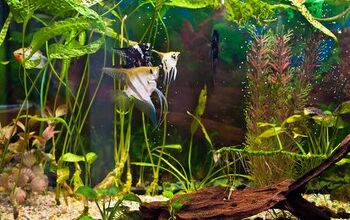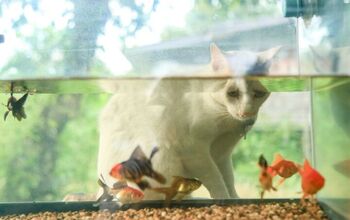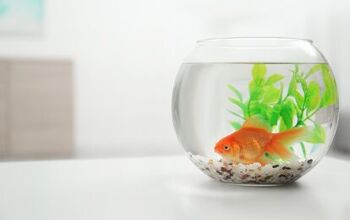How To Clean A Betta Fish Tank (Quickly & Easily!)

Betta fish are some of the most popular pet fish you can buy in a pet store, but that doesn’t mean that they’re always easy to care for. Like most other fish, bettas need to have a clean tank. An unclean tank puts them at risk of anxiety, disease, and death. It’s a fact, and a dirty fish tank can easily cut your fish’s lifespan significantly. So before you get those pretty fighting fish, it’s better to learn how to clean your tank.
Cleaning a betta fish tank is easy, but tedious. In order to do this, you will need to do the following:
- Start by warming up water to match the temperature of your fish tank and removing your fish from the tank.
- Then begin siphoning out your tank’s water and scrub down the sides of the tank.
- Once the tank’s walls are clean, use a tiny wet vacuum to clean the substrate.
- Stir water in hard to reach places, replace your filter, and then stop the siphon.
- Refill your tank with new water and add the fish.
Getting your fish’s tank clean is a major ordeal, but it’s the only way to make sure that your fish stay alive and well. This guide will give you a closer take on how to give your tank a thorough cleaning.
Do You Need a Maid Service?
Get free, zero-commitment quotes from pro contractors near you.

Cleaning A Betta Tank: The Full Process
Though we explained it pretty well up top, there are still some minor details that you need to be aware of before you start cleaning. Let’s take a look at each portion of the cleaning process.
Prepping The Water
The first thing that you need to do is prep some water. With most other fish, you may need to get specialty fish water or saltwater, but not bettas! On the most basic level, these fish just need to have tap water that’s warmed up to your tank’s current temperature. Though the temperature is the biggest issue, there are some other factors you need to know…
- Remember, the ideal pH is 7.0 for bettas. They can withstand slightly above, or slightly below.
- If you want to pamper your bettas, it’s good to know that most aquarium stores carry Betta Water, which has all the minerals they need to stay happy and healthy.
- Tap water is the best cheap alternative, but if you have tap water, make sure to add some water conditioner. This will neutralize chlorine, which can potentially poison your fish.
- Do not get distilled water for betta fish! Distilled water has none of the minerals that they need in order to stay alive. This can cause them to feel listless or even shorten their lifespan.
- Bettas are freshwater fish.
Siphon And Scrub
To fully clean a fish tank, you need to start siphoning out the water and remove the algae from the sides of the tank. Ideally, you should try to replace at least 10 to 25 percent of your tank’s water per month. If you replace more, that’s totally fine. It just needs to stay fresh.
- If you have a fish tank, you probably have a siphon in the form of an aquarium vacuum. If you don’t, take a large plastic hose and give it a gentle inhale to get the siphon going, Let the hose start draining the water out of your tank.
- While you are siphoning the tank out, take a sponge and scrub the sides of the tank. This will get rid of the algae. Try to make it fall out in clumps. Remove as much algae as you can, using the aquarium vacuum
- Keep an eye on the corners, since that’s where most algae tends to congregate. This is a must!
Focus On The Substrate
The substrate is all the gravelly stuff that you use to line your fish tank’s bottom, and it’s a magnet for both waste and algae. Thankfully, this is not too difficult to do.
- Use your aquarium vacuum to clean the substrate. You should give your substrate a little bit of a toss. You don’t want to suck up the beads/glass/dirt, but you do want to remove algae as much as you can. If you can, scoop up the gravel and run it through a sieve to get rid of excess slime and dirt.
- If your substrate looks really bad, then you should replace it with new stuff. For example, if you see your substrate growing copious amounts of algae, it may be better to replace it.
- If your decorations look foul, remove them from the tank and give them a good scrub-down. A brush or a sponge will remove algae and bacteria buildup.
Add The Finishing Touches
A lot of the minor tweaks you need to do in order to finish up a cleaning session matter more than you think. Here’s what you will need to do in order to complete your tank cleaning session…
- Start by swirling around stagnant water in hard-to-reach places. If your fish has a little castle that it enjoys swimming around in, lift it up and swirl the water around. Stagnant water is dirty water.
- Then, change the filter or clean the filter in your tank. Much like how your refrigerator’s water filter needs a change once in a while, so does your fish tank. If your filter is stuck, you can actually use similar techniques to getting your house’s water filter unstuck to loosen things up.
- Finally, stop your siphon. You can do this by just removing the tube from the water.
Add Your New Water And Fish
Now that the water is sufficiently warmed up, you can add your water and let your bettas swim in their newly-cleaned tank. Enjoy your clean swim, fishies!
How Often Should You Clean Your Betta’s Tank?
Bettas, like all other fish, need regular cleaning in order to keep themselves alive. While they are hardy compared to most other fish species sold as pets, they’re still delicate. Unfortunately, this is not an easy to answer question. It all depends on the size of the tank.
- Smaller tanks require you to do light cleaning every few days. These tanks, which are under 2.5 gallons in size, need you to replace 30 to 50 percent water every couple of days. A full cleaning should be done at least once a week.
- If your fish has a five-gallon tank or larger, you should remove 10 to 15 percent of the water at least once a week. Cleanings can be done once every two weeks.
- Small filtered tanks can have 10 to 15 percent of their water changed weekly. Larger tanks can have their water cleaned even less frequently, which is why they are so popular with betta fish.
- Betta owners who notice that their tank is looking under the weather should step up their cleaning game. Betta water gets foul far before it becomes visibly apparent. If your tank is already looking murky, the chances of your fish getting sick is high.
How Warm Should Your Betta Tank Be?
Bettas are big fans of warm, room-temperature water. If you want to be more specific about the tank temperature, keep the water between 76 and 80 degrees Fahrenheit. Any warmer may make your fish feel sick, while colder temperatures may make them feel lethargic.
Do You Need To Get A Filter For A Betta Tank?
There are a lot (and I mean a LOT) of fish species that basically require people to run a filter as a part of their tank. Bettas, being hardy fishes typically sold to beginner pet owners, don’t need a filter in their tank. However, it’s still a highly recommended part of your tank’s setup. This allows you to space out your cleaning more and also can improve the quality of your fish’s water overall.
Do You Need a Maid Service?
Get free, zero-commitment quotes from pro contractors near you.

Related Questions
Why shouldn’t you change all your aquarium’s water?
It may seem strange that you shouldn’t change your water entirely when you’re cleaning a tank, but there’s a reason for this. When bettas live in water, a certain amount of beneficial bacteria starts to build up in the water. This extends their lives. If you remove the water entirely, you lose that bacterial culture that protects the fish.As a result, they need to keep a certain amount of old water in their tanks at all times. It’s how they keep healthy and it’s one of the most common ways to help improve your fish’s immune system. After all, fish can get sick too.
Are betta fish good pets for beginners?
Betta fish are some of the easiest fish to care for and are known for being easy to work with. If you are looking for a relatively low-maintenance pet, then a betta fish is a good place to start. Other good options include zebrafish, tetras of all colors, guppies, loaches, and freshwater angelfish.Though goldfish have a reputation for being good beginner fish, this really isn’t true. They tend to require better care than most others and tend to have their lives cut significantly shorter when neglected.

Ossiana Tepfenhart is an expert writer, focusing on interior design and general home tips. Writing is her life, and it's what she does best. Her interests include art and real estate investments.
More by Ossiana Tepfenhart














![How Much Weight Can a 4×4 Support Horizontally? [It Depends!]](https://cdn-fastly.upgradedhome.com/media/2023/07/31/9070333/how-much-weight-can-a-44-support-horizontally-it-depends.jpg?size=350x220)












